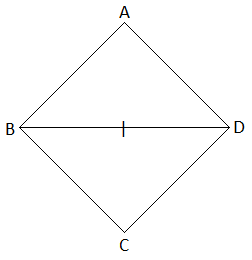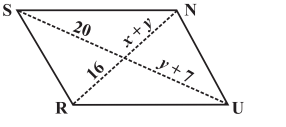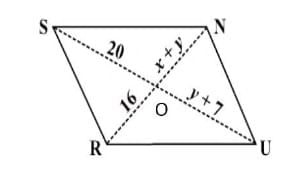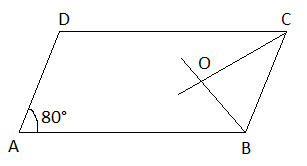Unit Test(Solutions): Understanding Quadrilaterals | Mathematics (Maths) Class 8 PDF Download
Time: 1 hour
M.M. 30
Attempt all questions.
Question numbers 1 to 5 carry 1 mark each.
Question numbers 6 to 8 carry 2 marks each.
Question numbers 9 to 11 carry 3 marks each.
Question number 12 & 13 carry 5 marks each
Q1: How many sides does a regular polygon have if the measure of an exterior angle is given as 24°? (1 Mark)
Ans: To find the number of sides of a regular polygon, use the formula for the exterior angle of a regular polygon:
Exterior angle=360/ Number of sides
Given that the exterior angle is 24°:
24°360
Solving for n:
n=15
The polygon has 15 sides.
Q2: What is the measure of each exterior angle of a regular polygon with 20 sides? (1 Mark)
(i) 20°
(ii) 18°
(iii) 30°
(iv) 45°
Ans:
The formula for the exterior angle of a regular polygon is:
For a polygon with 20 sides:
Q3: Select a false statement from those given below:( 1 Mark)
(i) A square is a rectangle that has equal adjacent sides
(ii) A square is a rhombus whose one angle is a right angle
(iii) The diagonals of a square bisect each other at right angles
(iv) The diagonals of a square do not divide the whole square into four equal parts.
Ans: (iv)
The diagonals of a square do divide the whole square into four equal parts, making statement (iv) false.
Q4: When one angle of a parallelogram is a right angle, then what is the name of the quadrilateral?
Ans: If one angle of a parallelogram is a right angle, then all angles must be right angles, making the quadrilateral a rectangle.
Q5: When the sum of the internal angles of a polygon is 10 right angles, then how many sides does it have? (1 Mark)
Ans: The sum of the interior angles of a polygon with
Given that the sum of the interior angles is 10 right angles (which is 10 × 90
Solve for n:
n−2 = 5
n = 5 + 2 = 7
n = 7
Q6 : A quadrilateral has three acute angles, each measure 80°. What is the measure of the fourth angle? ( 2 Marks)
Ans:
Let x be the measure of the fourth angle of a quadrilateral.
Sum of the four angles of a quadrilateral = 360°
80° + 80° + 80° + x = 360°
x = 360° – (80° + 80° + 80°)
x = 360° – 240°
x = 120°
Hence, the fourth angle is 120°.
Q7: The angles of a quadrilateral are in the ratio of 1 : 2 : 3 : 4. What is the measure of the four angles?( 2 Marks)
Ans: Given,
The ratio of the angles of quadrilaterals = 1 : 2 : 3 : 4
Let the four angles of the quadrilateral be x, 2x, 3x, and 4x respectively.
The sum of four angles of a quadrilateral is 360°.
Therefore,
x + 2x + 3x + 4x = 360°
10x = 360°
x = 360°/10
x = 36°
Therefore,
First angle = x = 36°
Second angle = 2x = 2 × 36 = 72°
Third angle = 3x = 3 × 36 = 108°
Fourth angle = 4x = 4 × 36 = 144°
Hence, the measure of four angles is 36°, 72°, 108° and 144°.
Q8: In quadrilaterals, (2 Marks)
(i) which of them have their diagonals bisecting each other?
(ii) which of them have their diagonal perpendicular to each other?
(iii) which of them have equal diagonals?
Ans:
(i) Diagonals bisect each other in: Parallelogram, Rhombus, Rectangle, Square.
(ii) Diagonals are perpendicular in: Rhombus, Square, Kite
(iii) Diagonals are equal to each other in: Rectangle, Square
Q9: Find the measure of all four angles of a parallelogram whose consecutive angles are in the ratio 1 : 3. (3 Marks)
Ans:
Given,
The ratio of two consecutive angles of a parallelogram = 1 : 3
Let x and 3x be the two consecutive angles.
We know that the sum of interior angles on the same side of the transversal is 180°.
Therefore, x + 3x = 180°
4x = 180°
x = 180°/4
x = 45°
⇒ 3x = 3(45°) = 135°
Thus, the measure of two consecutive angles is 45° and 135°.
As we know, the opposite angles of a parallelogram are equal.
Hence, the measure of all four angles is 45°, 135°, 45°, and 135°.
Q10: A diagonal and a side of a rhombus are of equal length. Find the measure of the angles of the rhombus.(3 Marks)
Ans:
Let ABCD be the rhombus.
Thus, AB = BC = CD = DA
 Given that a side and a diagonal are equal.AB = BD (say)
Given that a side and a diagonal are equal.AB = BD (say)
Therefore, AB = BC = CD = DA = BD
Now, all the sides of a triangle ABD are equal.
Therefore, ΔABD is an equilateral triangle.
Similarly,
ΔBCD is also an equilateral triangle.
Thus, ∠A = ∠ABD = ∠ADB = ∠DBC = ∠C = ∠CDB = 60°
∠B = ∠ABD + ∠DBC = 60° + 60° = 120°
And
∠D = ∠ADB + ∠CDB = 60° + 60° = 120°
Hence, the angles of the rhombus are 60°, 120°, 60° and 120°.
Q11: In the following figure, RUNS is a parallelogram. Find x and y. (Lengths are in cm) (3 Marks)
Ans: In a parallelogram, the diagonals bisect each other. This means the diagonals divide each other into two equal parts. We can use this property to find the values of x and y.
From the diagram, the diagonals RN
Considering diagonal SU,
OU = SO
y + 7 = 20 (diagonals divide each other into two equal parts)
y = 20 - 7
y = 13
Considering diagonl RN,
NO = OR
x + y = 16 (diagonals divide each other into two equal parts)
x + 13 = 16
x = 3
Q12: Adjacent sides of a rectangle are in the ratio 5 : 12, if the perimeter of the rectangle is 34 cm, find the length of the diagonal. (5 Marks)
Ans:
Given,
Ratio of the adjacent sides of the rectangle = 5 : 12
Let 5x and 12x be the two adjacent sides.
We know that the sum of all sides of a rectangle is equal to its perimeter.
Thus,
5x + 12x + 5x + 12x = 34 cm (given)
34x = 34
x = 34/34
x = 1 cm
Therefore, the adjacent sides are 5 cm and 12 cm respectively.
i.e. l = 12 cm, b = 5 cm
Length of the diagonal = √(l2 + b2)
= √(122 + 52)
= √(144 + 25)
= √169
= 13 cm
Hence, the length of the diagonal is 13 cm.
Q13: ABCD is a parallelogram with ∠A = 80°. The internal bisectors of ∠B and ∠C meet each other at O. Find the measure of the three angles of ΔBCO. (5 Marks)
Ans:
Given,
∠A = 80°

We know that the opposite angles of a parallelogram are equal.
∠A = ∠C = 80°
And
∠OCB = (1/2) × ∠C
= (1/2) × 80°
= 40°
∠B = 180° – ∠A (the sum of interior angles on the same side of the transversal is 180)
= 180° – 80°
= 100°
Also,
∠CBO = (1/2) × ∠B
= (1/2) × 100°
= 50°
By the angle sum property of triangle BCO,
∠BOC + ∠OBC + ∠CBO = 180°
∠BOC = 180° – (∠OBC + CBO)
= 180° – (40° + 50°)
= 180° – 90°
= 90°
Hence, the measure of all three angles of a triangle BCO is 40°, 50° and 90°.
|
81 videos|423 docs|31 tests
|
FAQs on Unit Test(Solutions): Understanding Quadrilaterals - Mathematics (Maths) Class 8
| 1. What are the different types of quadrilaterals and their properties? |  |
| 2. How can I calculate the area of different quadrilaterals? |  |
| 3. What is the sum of the interior angles of a quadrilateral? |  |
| 4. How do I identify a quadrilateral in a real-world context? |  |
| 5. What are the differences between a parallelogram and a rectangle? |  |






















